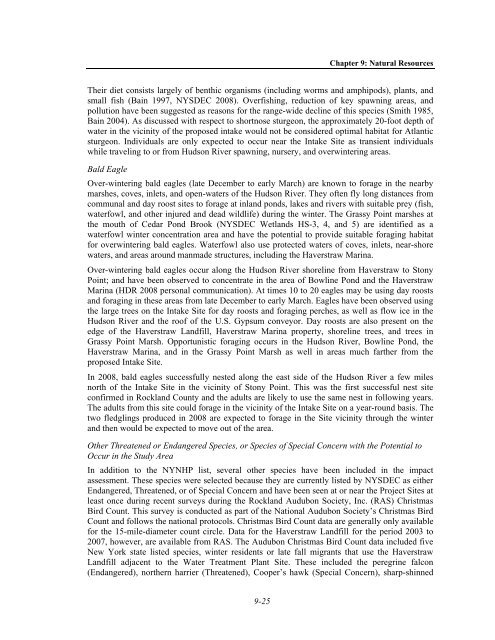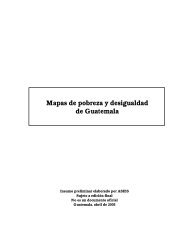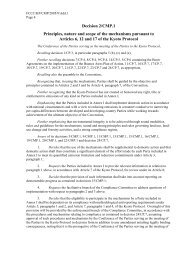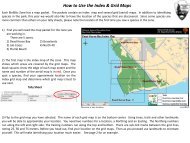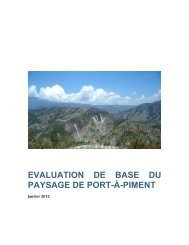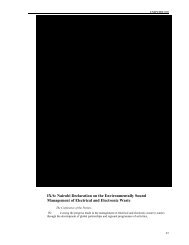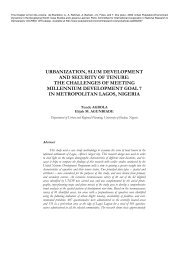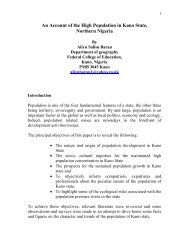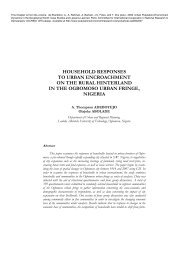Haverstraw Water Supply Project DEIS
Haverstraw Water Supply Project DEIS
Haverstraw Water Supply Project DEIS
Create successful ePaper yourself
Turn your PDF publications into a flip-book with our unique Google optimized e-Paper software.
Chapter 9: Natural ResourcesTheir diet consists largely of benthic organisms (including worms and amphipods), plants, andsmall fish (Bain 1997, NYSDEC 2008). Overfishing, reduction of key spawning areas, andpollution have been suggested as reasons for the range-wide decline of this species (Smith 1985,Bain 2004). As discussed with respect to shortnose sturgeon, the approximately 20-foot depth ofwater in the vicinity of the proposed intake would not be considered optimal habitat for Atlanticsturgeon. Individuals are only expected to occur near the Intake Site as transient individualswhile traveling to or from Hudson River spawning, nursery, and overwintering areas.Bald EagleOver-wintering bald eagles (late December to early March) are known to forage in the nearbymarshes, coves, inlets, and open-waters of the Hudson River. They often fly long distances fromcommunal and day roost sites to forage at inland ponds, lakes and rivers with suitable prey (fish,waterfowl, and other injured and dead wildlife) during the winter. The Grassy Point marshes atthe mouth of Cedar Pond Brook (NYSDEC Wetlands HS-3, 4, and 5) are identified as awaterfowl winter concentration area and have the potential to provide suitable foraging habitatfor overwintering bald eagles. <strong>Water</strong>fowl also use protected waters of coves, inlets, near-shorewaters, and areas around manmade structures, including the <strong>Haverstraw</strong> Marina.Over-wintering bald eagles occur along the Hudson River shoreline from <strong>Haverstraw</strong> to StonyPoint; and have been observed to concentrate in the area of Bowline Pond and the <strong>Haverstraw</strong>Marina (HDR 2008 personal communication). At times 10 to 20 eagles may be using day roostsand foraging in these areas from late December to early March. Eagles have been observed usingthe large trees on the Intake Site for day roosts and foraging perches, as well as flow ice in theHudson River and the roof of the U.S. Gypsum conveyor. Day roosts are also present on theedge of the <strong>Haverstraw</strong> Landfill, <strong>Haverstraw</strong> Marina property, shoreline trees, and trees inGrassy Point Marsh. Opportunistic foraging occurs in the Hudson River, Bowline Pond, the<strong>Haverstraw</strong> Marina, and in the Grassy Point Marsh as well in areas much farther from theproposed Intake Site.In 2008, bald eagles successfully nested along the east side of the Hudson River a few milesnorth of the Intake Site in the vicinity of Stony Point. This was the first successful nest siteconfirmed in Rockland County and the adults are likely to use the same nest in following years.The adults from this site could forage in the vicinity of the Intake Site on a year-round basis. Thetwo fledglings produced in 2008 are expected to forage in the Site vicinity through the winterand then would be expected to move out of the area.Other Threatened or Endangered Species, or Species of Special Concern with the Potential toOccur in the Study AreaIn addition to the NYNHP list, several other species have been included in the impactassessment. These species were selected because they are currently listed by NYSDEC as eitherEndangered, Threatened, or of Special Concern and have been seen at or near the <strong>Project</strong> Sites atleast once during recent surveys during the Rockland Audubon Society, Inc. (RAS) ChristmasBird Count. This survey is conducted as part of the National Audubon Society’s Christmas BirdCount and follows the national protocols. Christmas Bird Count data are generally only availablefor the 15-mile-diameter count circle. Data for the <strong>Haverstraw</strong> Landfill for the period 2003 to2007, however, are available from RAS. The Audubon Christmas Bird Count data included fiveNew York state listed species, winter residents or late fall migrants that use the <strong>Haverstraw</strong>Landfill adjacent to the <strong>Water</strong> Treatment Plant Site. These included the peregrine falcon(Endangered), northern harrier (Threatened), Cooper’s hawk (Special Concern), sharp-shinned9-25


